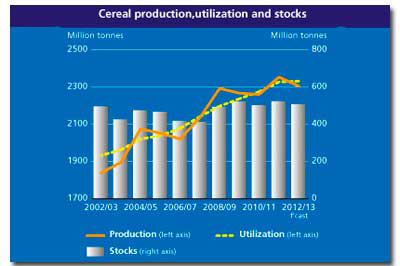FAO report predicts growth for 2013 cereal production

Strong growth in the 2013 global wheat, coarse grains and rice production, is expected according to early forecasts published in the May issue of FAO’s monthly Cereals Supply and Demand Brief.
Assuming more normal weather conditions than in 2012, global wheat production in 2013 is expected to reach 695 million tonnes, 5.4% up from last year’s harvest and just some 6 million tonnes short of the 2011 record level.
And in 2013, coarse grains production is expected to set a new record at 1 266 million tonnes – 9.3% up on the previous high of 1 167 million tonnes registered in 2011.
Of this total, maize is forecast to account for about 960 million tonnes, some 10% up from 2012. The bulk of the increase is expected in the United States, the world’s largest producer, where maize plantings are forecast to reach their highest level since 1936. Recovery from drought in the major CIS producing countries should also contribute significantly to the record global production.
Still tentatively, FAO foresees rice production in the forthcoming 2013 season to rise to 497.7 million tonnes, 16 million tonnes more than in 2012, with particularly large increases expected in India and Indonesia.
Cereal utilisation
Despite the expected production increases, world cereal utilisation is expected to stagnate in 2012/2013, constrained by rising grain prices and faltering ethanol demand. Global cereal utilisation is now forecast to be 2 332 million tonnes, roughly unchanged from the 2011/12 level.
World cereal stocks by the close of seasons ending in 2013 are forecast at 505 million tonnes, up 1% (5 million tonnes) from the previous forecast, but some 3% (16 million tonnes) below their opening levels.
A sharp fall in world cereal trade is expected in 2012/13, involving all major cereals. At 304.4 million tonnes, it would be almost 1 million tonnes larger than forecast last month, but still representing a decline of about 4% (13 million tonnes) from 2011/12.
FAO Food Price Index up for second month running
FAO’s Food Price Index rose for the second month running in April, climbing 1% or two points.
As in March, last month’s increase was driven almost exclusively by a sharp rise in dairy prices. Prices of most other food commodities fell. At 215.5 points the April Food Price Index was also 1% higher than in April 2012 It currently stands 9% below its peak recorded in February 2011.
The FAO Dairy Price Index averaged 259 points in April, a rise of nearly 34 points (14.9%) from March and the second largest monthly change on record. The main cause was a steep decline in milk production in New Zealand, the world’s largest dairy exporter.
The FAO Cereal Price Index averaged 235 points in April, down 10 points (4.1%) from March, but nearly 11 points (4.9%) over April 2012.
The FAO Oils/Fats Price Index averaged 199 points in April, down 2 points (1.5%) from March. Weakening energy prices and persistent concerns about the global economy continued to weigh on the vegetable oil complex as a whole.
The FAO Meat Price Index averaged 179 points in April, a level which it has maintained since the latter part of 2012, moving within the narrow band of 177 – 179. Nevertheless, meat prices overall remain high by historical standards.
The FAO Sugar Price Index averaged 253 points in April, down over 9 points (3.6%) from March.











